Episodes
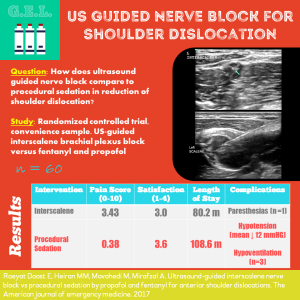
Monday Jun 19, 2017
Ultrasound Guided Nerve Block for Shoulder Dislocations
Monday Jun 19, 2017
Monday Jun 19, 2017
You are treating someone with a shoulder dislocation. You have a few options that can be used to help put it back where it belongs: A) Procedural sedation - the old standby. B) Intraarticular injection - some people love it, some hate it C) Relaxational maneuvers - sometimes feasible, and, last but not least D) Regional anesthesia - the new kid on the (nerve) block. This study compares procedural sedation to regional anesthesia with an ultrasound guided interscalene nerve block for the outcomes of pain and length of stay (and a few other things too).
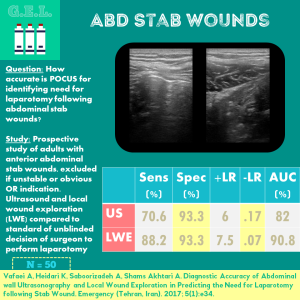
Monday Jun 05, 2017
Ultrasound for Abdominal Stab Wounds
Monday Jun 05, 2017
Monday Jun 05, 2017
The idea here is that some people that suffer the misfortune and inconvenience of being stabbed in the abdomen will require a surgical laparotomy. On the other hand, some will not. We don't want to miss the ones that do, but we don't want the latter to get unnecessary operations. If the wound does not penetrate so deep as to violate the peritoneum then there is low risk of intraabdominal organ injury. Instead of probing and exploring the wound which can be painful, perhaps ultrasound can offer a less invasive way of determining whether or not the peritoneum was violated.
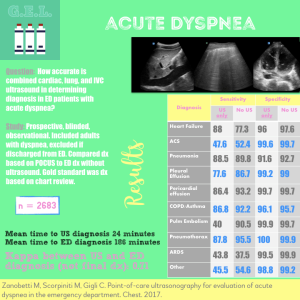
Monday May 22, 2017
Acute Dyspnea
Monday May 22, 2017
Monday May 22, 2017
Feeling out of breath or having trouble breathing (AKA dyspnea) is a common complaint in the emergency department. We know already that ultrasound can diagnose a number of things that can cause this symptom. This paper takes a look to see how ultrasound can help out the evaluation of a patient who presents with acute dyspnea. More specifically, it looks at the accuracy of diagnosis and time to making the diagnosis compared to an evaluation without ultrasound.
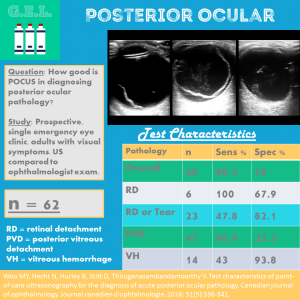
Monday May 08, 2017
Ultrasound for Posterior Ocular Pathology
Monday May 08, 2017
Monday May 08, 2017
The eye was made to ultrasound - it is fluid filled and easy to find. Ultrasound can be used to diagnose many causes of acute visual complaints. This is important because often times a) comprehensive dilated fundoscopy is not feasible and b) there are no ophthalmologists around. So how good is it? This study compares point of care ultrasound to an ophthalmologists exam in diagnosing posterior ocular pathology such as retinal detachment, vitreous detachment, and vitreous hemorrhage.
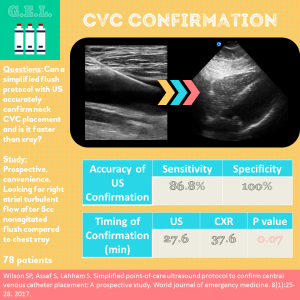
Monday Apr 24, 2017
Simplified CVC Confirmation
Monday Apr 24, 2017
Monday Apr 24, 2017
Central lines are often needed in the sickest patient, and after we place them, we usually need to use them quickly. Traditionally, this means tapping your foot anxiously while waiting for a chest xray to confirm that the catheter is in the appropriate place. Well guess what - it turns out that ultrasound is pretty good at determining correct placement, at the bedside, right away. This study attempts to use a simplified flush protocol to see how accurately and how quickly ultrasound can confirm catheters placed in the internal jugular or subclavian veins.
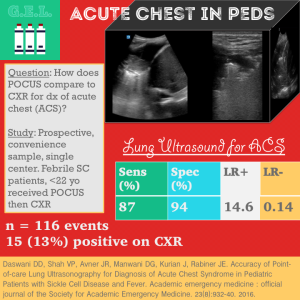
Monday Apr 10, 2017
Acute Chest Syndrome in Pediatric Patients
Monday Apr 10, 2017
Monday Apr 10, 2017
Acute chest syndrome (ACS) is a feared complication of patients with sickle cell disease. Usually, whenever there is clinical concern for ACS, the first step is obtaining a chest xray. In an effort to reduce radiation to our vulnerable youth, this study examines the accuracy of point of care lung ultrasound in making the diagnosis compared to the chest xray.
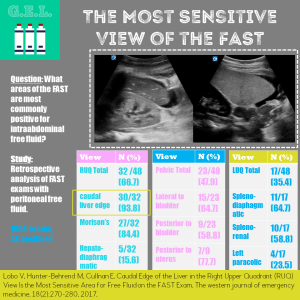
Monday Mar 27, 2017
The Most Sensitive View of the FAST
Monday Mar 27, 2017
Monday Mar 27, 2017
The FAST exam (focused assessment with sonography in trauma) looks for two things - intraperitoneal free fluid in the abdomen and fluid around the heart. With regard to the abdomen, there are a lot of places the fluid can go. It would be helpful to know in which areas the fluid most commonly collects so you can make sure not to miss any. These authors break down each of the three abdominal FAST views (right upper quadrant, left upper quadrant, and suprapubic/pelvic) into three "sub-quadrants." Then they take a look at all the FAST exams done at their institution over a year and a half and determine how often the fluid goes to each of those places when there is a positive exam.
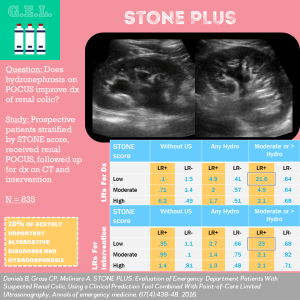
Monday Mar 13, 2017
STONE PLUS - a Tool for Renal Colic
Monday Mar 13, 2017
Monday Mar 13, 2017
Kidney stones can be tricky - who needs a CT? Who can go home? (Don't get us started about who needs tamsulosin.) POCUS now plays a key role in the diagnosis and management of these patients. This study takes a look at how well a clinical prediction tool that incorporates a bedside ultrasound can predict the diagnosis of renal colic and the need for intervention.
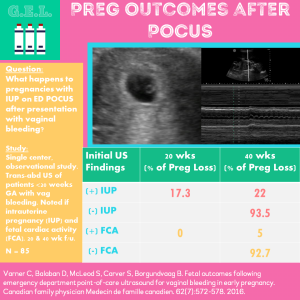
Monday Feb 27, 2017
Fetal Outcomes After POCUS for Vaginal Bleeding in Pregnancy
Monday Feb 27, 2017
Monday Feb 27, 2017
When patients come into the emergency department with vaginal bleeding, they often get a bedside point-of-care ultrasound (POCUS) to assess if this is an intrauterine pregnancy and to assess fetal viability when possible. We know that finding evidence of an intrauterine pregnancy and finding a fetal heart beat is good news for the pregnancy - but how good? What are the chances that these pregnancies will continue to full term? This paper follows these patients up to find out.
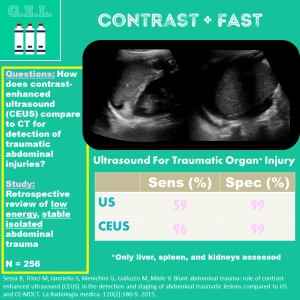
Monday Feb 13, 2017
Contrast Ultrasound in Trauma
Monday Feb 13, 2017
Monday Feb 13, 2017
The FAST (focused assessment with sonography for trauma) is great for picking up free fluid in cases of intraabdominal hemorrhage; however, it is not so good at diagnosing solid organ injury. What about if we add contrast? This articles takes a look at the use of contrast-enhanced ultrasound in blunt abdominal trauma patients. Is this the next cool thing in trauma diagnostics?

